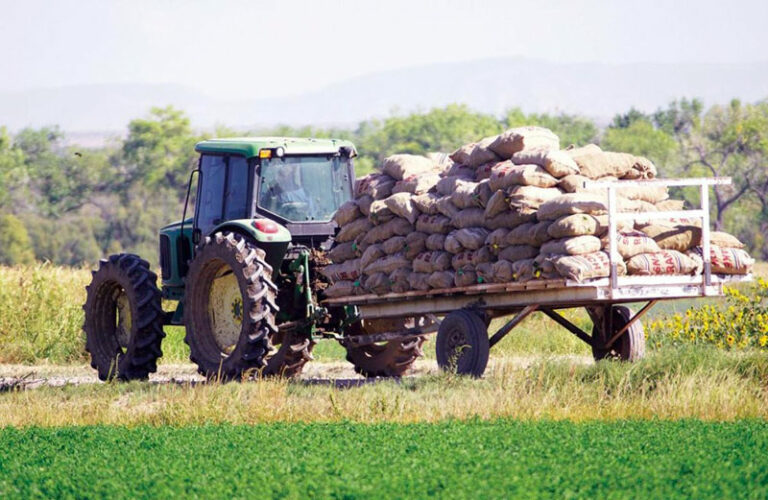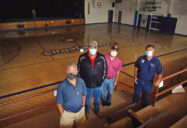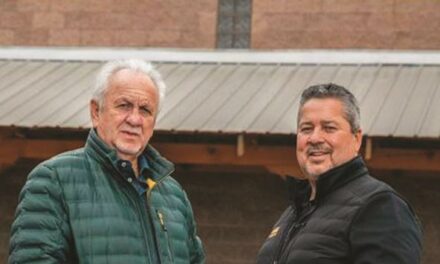
A tractor hauls away sacks of chile on the Sichler family Snake Ranch Farm north of San Antonio. Despite water shortages, labor shortages and coronavirus complications, owner Chris Sichler is anticipating at least an average chile production and sales year.
Adolphe Pierre-Louis | Albuquerque Journal
ESCONDIDA — “We’re out of chile. We open at 9 tomorrow. Come back then.”
It is about 1:30 p.m. on a recent weekday. Linda Rosales, co-owner, with her husband Mario, of Rosales Produce, is talking to a man standing just outside the closed gate of her business.
The man explains that he has driven a ways to get there.
“Don’t you have even one sack,” he asked.
“No. I’m sorry. We don’t,” she said.
Rosales’ farm stand on NM 408, just east of I-25, is out of chile for the day. But the chile plants in the Rosales farm fields a short distance north in Lemitar are bristling with chile — green chile, green-gold chile, red chile.
“The production is there,” Rosales, 64, said. “We can’t get enough labor to get it picked. If we could get it picked, I’d be selling all day. People are stocking up on chile like they were on toilet paper.”
She said she started noticing a labor problem last year but said it is a whole lot worse now. She is not sure why.
“It could be related to the coronavirus,” she said.
Mexican nationals who have legal immigration status make up much of the workforce in New Mexico’s chile fields. Travel restrictions and quarantines mandated by the pandemic may be making it difficult for some of them to get to work.
“Or it could be no one wants to get in groups,” Rosales said. “It could be they are really scared.”
Always something
Farming is never easy. Something always goes wrong. But this year, chile producers in Socorro County, as well as in other parts of the state, might be thinking everything that could go wrong did.
There has been a severe shortage of irrigation water, not enough rain or too much rain, prolonged periods of extreme heat, hail and the complications of the pandemic.
Socorro County Extension Agent Emily Bruton said the state of chile crops varies from farm to farm in the county.
“The water situation has certainly been difficult this year,” she said. “We are running out of water and that is a problem for all farmers in the valley who depend on flood irrigation. The rain has not been what it should be. We did have some rain right at the start of the season, and then it kind of tapered off. Then we had some rain that caused flooding and that was another kind of problem.”
The irrigation season usually starts in March and runs through Oct. 31, but this year it will end on Monday.
“We squeaked by by the skin of our teeth,” said David Gensler, water manager for the Middle Rio Grande Conservancy District, which is responsible for delivering irrigation water to 70,000 acres in the Middle Rio Grande Valley. “We have had rough years in the past, years with bad water storage, years with a lousy spring runoff and years we had no summer rain. But this is the first time in my 25 years with the distrist that we did not have at least one of those things — storage, runoff or rain — to help get us through.”
Gensler said the water would not have lasted as long as it did if the Rio Grande Compact Commission, made up of representatives from Texas, Colorado and New Mexico, had not given New Mexico permission in July to use 38,000 acre feet of water, more than 12 billion gallons, stored in El Vado Reservoir in Rio Arriba County.
“That was a godsend,” he said. “They did not have to do that and it was a big sacrifice on their part.”
Heat and hail
Even with the additional compact water, shortages proved to be a problem for farmers such as Kenneth Bustamante, 20, of Polvadera. Bustamante raises 200 acres of hay and 10 to 15 acres of chile. In a typical year, he said he will produce more than 1,000 sacks of green chile. This year he managed 400 sacks, which he sold to a grocery in Cedar Crest.
“Lack of water has been a problem for the chile,” he said. “We generally irrigate every two weeks, but we went to three weeks. Then we had a little cold front come through and turn the chile red. We are going to pick the red this winter for pods and powder.”
Bustamante is in his third year of farming on his own after working in previous years with his father. He said he also had trouble finding help this year.
“I usually have four pickers during the season but had one to two this year,” he said. “Mostly people were taking the (coronavirus-impact) unemployment and not wanting to work.”
Ken Armijo had enough water and enough help to take care of his five-acre farm in Sabinal. His problem is that he had too much heat and hail. Armijo, 67, grew up in Albuquerque and started farming in Sabinal in 1981. He has an eighth of an acre planted in chile and the remainder of his farmland in grass hay, garlic and a cover crop. He supplements irrigation water with drip irrigation.
“But it started to get real hot and the (chile) leaves began to droop,” he said. “We had over one month of 100-degree weather. In 100-degree heat (chile plant) blossoms fall off. Fifteen years ago I did not have that problem but it has gotten so much hotter.”
Armijo nursed his chile through the heat and by Aug. 15, he said his chile plants were healthy and boasting new pods.
“And then on Sept. 1, boom, hail blew out the chile pods, stripped leaves off and damaged stems,” he said. “I lost 50 percent of the new pods. I had enough left to roast and put in the freezer. What’s left in the field I let go red. I will make a lot of red chile, maybe for Christmas gifts.”
Go with it
Business is brisk in the Sichler Snake Ranch Farm Store on Main Street in Los Lunas. The pungent smell of roasting chile greets shoppers entering the store to buy their own chile and a variety of other produce.
“One thing that has happened with coronavirus is that people are cooking more at home, so business is up here in the store,” said Steven Sichler, 33, who manages the place. “Some customers are concerned (about COVID-19). But they just call us, roll up and we will bring out their order.”
Steven represents the sixth generation of his family to farm in New Mexico. He is a partner with his father, Chris, and mother, Paula, in the Snake Ranch farming operation about a mile north of San Antonio and in Sichler Farms Produce, which has a Snake Ranch Farm Store in San Antonio in addition to the one in Los Lunas. Paula manages the San Antonio store.
In 1985, three days after he graduated from Los Lunas High School, Chris Sichler moved to Socorro County to manage the farm near San Antonio. According to the family story, the farm got its present name when a neighbor, observing some crooked farm rows young Chris had laid down, asked Chris if he were starting a snake ranch. Today, the 650-acre farm produces alfalfa, corn, oats, watermelons, cantaloupes, pumpkins, squash, tomatoes, cucumbers and other crops in addition to 50 acres of chile. The Sichlers have five wells from which they can get water to augment MRGCD irrigation.
Steven said that although Snake Farm grew a “really great crop” of chile this year, the family’s wholesale business suffered because “we just have not been able to pick it hard.”
The problem, he said, is the labor shortage that Linda Rosales and Kenneth Bustamante cited. He said coronavirus restrictions may be partly to blame but there’s more to it than that.
“All the (Mexican national) men with the correct paperwork are in their 50s and 60s,” he said. “They are aging out of the labor market.”
In 1986, Congress passed the Immigration and Reform and Control Act, which made it illegal to knowingly hire illegal immigrants but which also granted legal immigration status (immigration amnesty) to many persons who were in the United States unlawfully. Since then Congress has approved additional amnesties, but none in the last 20 years.
Chris Sichler said that today American employers must apply for H-2A visas which allow foreign nationals to enter the United States for temporary agriculture work.
“H-2A is geared toward big corporate farms,” Chris, 53, said. “It’s a lot of paperwork. I need 12 guys and I have eight or nine, that’s too much paperwork for three or four people. And it’s expensive.” He said the situation makes family farms an endangered species because it is tough for them to compete with big operations for workers.
Chris is at the Snake Ranch farm, standing out of the heat in a shed in which alfalfa is stored. In a field near the shed men are picking chile, sacking it and loading it on a trailer pulled by a tractor. Chris believes his chile production and sales will be at least average this year.
“Everything has worked out for us,” he said. “Our business is up in our stores, so we can cut the wholesale out. I’ve got a decent crew.
“I’ve got a lot of faith in God and just go with it and see how it works out at the end of the year.”
Racing the freeze
Linda Rosales is driving her 2002 Chevrolet Silverado from her farm stand at Escondida north to her chile fields in Lemitar. “This truck has more than 600,000 miles on it,” she said. “Just driving back and forth with chile all these years.”
Besides the Escondida store, Linda and Mario have an Albuquerque store at 7331 Fourth NW. The Rosales farm encompasses 300 acres planted in alfalfa; 30 or so acres in Sudan grass, a forage crop; and 65 acres in chile. The chile is planted in separate fields in an effort to avoid most or all of a crop being destroyed by a hail storm.
Usually eight to 10 men work the Rosales chile fields. This year there are just five, all Mexican nationals. They start work at about 6:30 a.m. and work to 4:30 p.m., with an hour off for lunch. Linda and Mario pay the men $3 per 40-pound sack.
“They pick 40 to 50 sacks a day,” Rosales said. She thinks it would be good if Congress made it easier for more Mexican nationals to work farm fields in the United States.
“Because they are dependable,” she said. “We have tried hiring local, but they don’t stay.”
Rosales turns the truck onto a road that goes around a chile field. The plants look pretty good.
“It was just the last month that the (irrigation) water was bad,” she said. “The rain has been spotty.”
Rosales stops the truck near the men working the fields. Getting out, she speaks to them in an easy, fluent Spanish, a language she learned only after marrying Mario 46 years ago.
She said the goal now is to get as much of the chile picked as possible before the first freeze.
“On average the first freeze is Oct. 28 to 30,” she said. “But last year it was Oct. 10. Once it was on Nov. 15, but that was a long time ago.”
She said the secret to picking chile is to keep your hands moving and feeling.
“The hardness indicates maturity,” she said. “That’s the chile you want to pick. Everything at the bottom (of the plant) is the hardest. You pick that first. The second picking is in the middle, and the third, if the weather holds, is on the top.”
Silver lining
Extension Agent Bruton said that every times she passes the Sichler stores and the Rosales farm stand they appear to have lots of customers.
“The coronavirus has added an extra layer of stress to farmers because they have protocols for keeping their employees and the people who purchase from them safe,” she said. “But I think there is a silver lining because people have thought a little more about food and food security. And I am hoping that helps them remember what farmers do for them.”



















